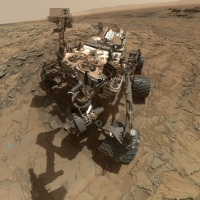The Mars Report – August 3rd, 2015

.
Welcome back My Dear Shoevians to The Other Shoe. And, welcome to an abbreviated edition of‘The Mars Report’. This week, well, there just isn’t than many new images (yet) from the; Curiosity Rover, Mars Reconnaissance Orbiter, and MARVEN. Our first image, at the top of the page, is anall new ‘Banner’ image I ‘borrowed’ from the NASA/JPL web site. Thought it might look nice, and add to the article as a whole. Let’s see if I get ‘sued’ for using it.
.
The image is of the Mars Reconnaissance Orbiter that currently obits the Martian surface. This orbiter has provided all of you, My Dear Shoevians, with some spectacular images, one of which will appear right here today. Since its landing the Curiosity rover is tracked by this orbiter, and on more than one occasion I have shared an image, taken by this orbiter, of the Curiosity rover on the Martian surface.
.
Now, for our first image of this article, I mentioned that this is a shortened version of this article series, due to my commitments this week. As I promised this image was taken by the Compact Reconnaissance Imaging Spectrometer for Mars (CRISM) on NASA’s Mars Reconnaissance Orbiter. The orbiter, Mars Reconnaissance Orbiter (MRO), has detected deposits of glass within impact craters on Mars. The deposits are shown, in the image, as green colored.
.

NASA Spacecraft Detects Impact Glass on Surface of Mars
[1]
(NASA Spacecraft Detects Impact Glass on Surface of Mars)
.
Now the interesting fact about this glass, and the reason that I have shared this image here today, is what is found in this ice.
.
“During the past few years, research has shown evidence about past life has been preserved in impact glass here on Earth. A 2014 study led by scientist Peter Schultz of Brown University in Providence, Rhode Island, found organic molecules and plant matter entombed in glass formed by an impact that occurred millions of years ago in Argentina. Schultz suggested that similar processes might preserve signs of life on Mars, if they were present at the time of an impact.”[2]
.
Like the “dino-DNA.. trapped in amber” (a la ‘Jurassic Park #1) this ice on the Martian surface could (easily) have trapped life forms from the surface at the time of impact. This give scientists are realopportunity to find out ‘was there life forms on Mars, before…?’. I am sure that the scientists, at NASA/JPL, have already put in their requests that future Martian landers make one of these sites a‘Must Visit’ site. The possibilities are astounding and limitless.
.
I have to tell you, My Dear Shoevians, this article may be short but images, like this one, are thereason that I write and publish this article series. The possibilities that come, when we explore our own solar system, are genuinely limitless. For as long as I breath air with these lungs, I will push my government and elected leaders to keep funding… advance funding for space exploration. With the challenge of ‘Climate Change’ becoming more and more evident every single day. Mankind mustrealize that the earth was our cradle, but it was never meant to be our grave.
.

Frosty Gullies on the Northern Plains of Mars
[3]
(Frosty Gullies on the Northern Plains of Mars)
.
Now, My Dear Shoevians, what we see before us (above) is large gullies of ice crystals on the Martian surface. Just like snow, here on Earth, ice forms during the winter months on the Martian surface. The biggest difference between the ice, here on Earth, to the ice formed on the Martian surface is composition. Here on Earth ice is formed by freezing H2O, whereas on the Martian surface it comes from frozen Co2 (Carbon Dioxide). Creating Dry Ice. Now the temperature that Co2 freezes is at -80.5 C (-113F ). That is some seriously cold air. You can rule out taking a Christmas Ride to Grandma’s in an Open Sleigh during a Martian winter! The image, acquired on April 11, 2015, by theHigh Resolution Imaging Science Experiment (HiRISE) camera on NASA’s Mars Reconnaissance Orbiter, shows frost in gully alcoves in a crater on the Northern plains.
.

NASA Mars Orbiter Preparing for Mars Lander’s 2016 Arrival
[4]
(NASA Mars Orbiter Preparing for Mars Lander’s 2016 Arrival)
.
There she is, the Mars Reconnaissance Orbiter (well, an Artist’s Rendering). On July 29th, 2015 NASA’s Mars Reconnaissance Orbiter successfully completed a maneuver to put the spacecraft in the right place on Sept. 28, 2016, for supporting arrival of the InSight Mars lander mission. This is the, previously featured here at The Other Shoe[5], ‘Insight Martian Lander’. ‘Insight’ is set to land, on the Martian surface, on September 28th, 2016 (right before our Presidential election, FYI).
.

InSight spacecraft solar array deployment
[6]
(InSight spacecraft solar array deployment)
.
Which brings us, My Dear Shoevians, to the final image of the day, for this edition of ‘The Mars Report’. For the very first time mankind has more orbiting objects circling Mars. The image, below, shows the flight paths of the five orbiters must be carefully monitored. Last year’s addition of two new spacecraft orbiting Mars brought the census of active Mars orbiters to five, the most ever. They are; NASA’s Mars Atmosphere and Volatile Evolution (MAVEN) and India’s Mars Orbiter Missionjoined the 2003 Mars Express from ESA (the European Space Agency) and two from NASA: the 2001 Mars Odyssey and the 2006 Mars Reconnaissance Orbiter (MRO).
.

Traffic Around Mars Gets Busy!
[7]
(Traffic Around Mars Gets Busy!)
.
“It’s not just the total number that matters, but also the types of orbits missions use for achieving their science goals. MAVEN, which reached Mars on Sept. 21, 2014, studies the upper atmosphere. It flies an elongated orbit, sometimes farther from Mars than NASA’s other orbiters and sometimes closer to Mars, so it crosses altitudes occupied by those orbiters. For safety, NASA also monitors positions of ESA’s and India’s orbiters, which both fly elongated orbits.[8]”
.
That brings us, My Dear Shoevians, to the end of another edition of ‘The Mars Report’. As always, I hope that you have enjoyed your time spent here, today. If you have, Please be sure to ‘Like’ and‘Share’ this article with all your social media. That way all of your; family, friends, and Facebook friends can enjoy this work, too. I will be off, tomorrow (August 4th 2015) for a ‘Journey to L.A.’!
.
Yes, it is that time again, where I make the 13 hour round trip to Rolling Hills Estates to see my primary/coordinating Care Physician. Once I have recovered from that adventure, I will be backright here providing you, My Dear Shoevians, with more and more articles to read and ENJOY!
.
Adieu!
.
Thank you!
.

Danny Hanning Writer, Editor, Research Staff and Publisher at The Other Shoe
© 2010 – 2015 Hanning Web Wurx and The Other Shoe
About Daniel Hanning









The Mars Report – August 3rd, 2015
August 3, 2015 Leave a comment
.
Welcome back My Dear Shoevians to The Other Shoe. And, welcome to an abbreviated edition of‘The Mars Report’. This week, well, there just isn’t than many new images (yet) from the; Curiosity Rover, Mars Reconnaissance Orbiter, and MARVEN. Our first image, at the top of the page, is anall new ‘Banner’ image I ‘borrowed’ from the NASA/JPL web site. Thought it might look nice, and add to the article as a whole. Let’s see if I get ‘sued’ for using it.
.
The image is of the Mars Reconnaissance Orbiter that currently obits the Martian surface. This orbiter has provided all of you, My Dear Shoevians, with some spectacular images, one of which will appear right here today. Since its landing the Curiosity rover is tracked by this orbiter, and on more than one occasion I have shared an image, taken by this orbiter, of the Curiosity rover on the Martian surface.
.
Now, for our first image of this article, I mentioned that this is a shortened version of this article series, due to my commitments this week. As I promised this image was taken by the Compact Reconnaissance Imaging Spectrometer for Mars (CRISM) on NASA’s Mars Reconnaissance Orbiter. The orbiter, Mars Reconnaissance Orbiter (MRO), has detected deposits of glass within impact craters on Mars. The deposits are shown, in the image, as green colored.
.
NASA Spacecraft Detects Impact Glass on Surface of Mars
[1]
(NASA Spacecraft Detects Impact Glass on Surface of Mars)
.
Now the interesting fact about this glass, and the reason that I have shared this image here today, is what is found in this ice.
.
.
Like the “dino-DNA.. trapped in amber” (a la ‘Jurassic Park #1) this ice on the Martian surface could (easily) have trapped life forms from the surface at the time of impact. This give scientists are realopportunity to find out ‘was there life forms on Mars, before…?’. I am sure that the scientists, at NASA/JPL, have already put in their requests that future Martian landers make one of these sites a‘Must Visit’ site. The possibilities are astounding and limitless.
.
I have to tell you, My Dear Shoevians, this article may be short but images, like this one, are thereason that I write and publish this article series. The possibilities that come, when we explore our own solar system, are genuinely limitless. For as long as I breath air with these lungs, I will push my government and elected leaders to keep funding… advance funding for space exploration. With the challenge of ‘Climate Change’ becoming more and more evident every single day. Mankind mustrealize that the earth was our cradle, but it was never meant to be our grave.
.
Frosty Gullies on the Northern Plains of Mars
[3]
(Frosty Gullies on the Northern Plains of Mars)
.
Now, My Dear Shoevians, what we see before us (above) is large gullies of ice crystals on the Martian surface. Just like snow, here on Earth, ice forms during the winter months on the Martian surface. The biggest difference between the ice, here on Earth, to the ice formed on the Martian surface is composition. Here on Earth ice is formed by freezing H2O, whereas on the Martian surface it comes from frozen Co2 (Carbon Dioxide). Creating Dry Ice. Now the temperature that Co2 freezes is at -80.5 C (-113F ). That is some seriously cold air. You can rule out taking a Christmas Ride to Grandma’s in an Open Sleigh during a Martian winter! The image, acquired on April 11, 2015, by theHigh Resolution Imaging Science Experiment (HiRISE) camera on NASA’s Mars Reconnaissance Orbiter, shows frost in gully alcoves in a crater on the Northern plains.
.
NASA Mars Orbiter Preparing for Mars Lander’s 2016 Arrival
[4]
(NASA Mars Orbiter Preparing for Mars Lander’s 2016 Arrival)
.
There she is, the Mars Reconnaissance Orbiter (well, an Artist’s Rendering). On July 29th, 2015 NASA’s Mars Reconnaissance Orbiter successfully completed a maneuver to put the spacecraft in the right place on Sept. 28, 2016, for supporting arrival of the InSight Mars lander mission. This is the, previously featured here at The Other Shoe[5], ‘Insight Martian Lander’. ‘Insight’ is set to land, on the Martian surface, on September 28th, 2016 (right before our Presidential election, FYI).
.
InSight spacecraft solar array deployment
[6]
(InSight spacecraft solar array deployment)
.
Which brings us, My Dear Shoevians, to the final image of the day, for this edition of ‘The Mars Report’. For the very first time mankind has more orbiting objects circling Mars. The image, below, shows the flight paths of the five orbiters must be carefully monitored. Last year’s addition of two new spacecraft orbiting Mars brought the census of active Mars orbiters to five, the most ever. They are; NASA’s Mars Atmosphere and Volatile Evolution (MAVEN) and India’s Mars Orbiter Missionjoined the 2003 Mars Express from ESA (the European Space Agency) and two from NASA: the 2001 Mars Odyssey and the 2006 Mars Reconnaissance Orbiter (MRO).
.
Traffic Around Mars Gets Busy!
[7]
(Traffic Around Mars Gets Busy!)
.
.
That brings us, My Dear Shoevians, to the end of another edition of ‘The Mars Report’. As always, I hope that you have enjoyed your time spent here, today. If you have, Please be sure to ‘Like’ and‘Share’ this article with all your social media. That way all of your; family, friends, and Facebook friends can enjoy this work, too. I will be off, tomorrow (August 4th 2015) for a ‘Journey to L.A.’!
.
Yes, it is that time again, where I make the 13 hour round trip to Rolling Hills Estates to see my primary/coordinating Care Physician. Once I have recovered from that adventure, I will be backright here providing you, My Dear Shoevians, with more and more articles to read and ENJOY!
.
Adieu!
.
Thank you!
.
Danny Hanning Writer, Editor, Research Staff and Publisher at The Other Shoe
© 2010 – 2015 Hanning Web Wurx and The Other Shoe
[1] http://www.nasa.gov/press-release/nasa-spacecraft-detects-impact-glass-on-surface-of-mars
[2] http://www.nasa.gov/press-release/nasa-spacecraft-detects-impact-glass-on-surface-of-mars
[3] http://www.nasa.gov/image-feature/frosty-gullies-on-the-northern-plains-of-mars
[4] http://www.nasa.gov/image-feature/frosty-gullies-on-the-northern-plains-of-mars
[5] The Mars Report – June 8th, 2015
[6] http://www.nasa.gov/jpl/pia19664/insight-lander-in-mars-surface-configuration
[7] http://www.nasa.gov/jpl/mars/traffic-around-mars-gets-busy
[8] http://www.nasa.gov/jpl/mars/traffic-around-mars-gets-busy
Share this:
Related
Filed under Lifestyles, NASA Mars Curiosity Rover, NASA Mars Mission, Science Tagged with Hubble HD Images From Space, Images, Lifestyles, Mars Curiosity, Mars Reconnaissance Orbiter, Mercury, Messenger, Messenger Mercury, NASA, NASA Messenger, NASA Messenger Mission to Mercury, NASA/JLP Mars Images, Neptune, Science, Social Commentary, Space Exploration, Space Exploration Daniel's Health, Space Exploration Electronics, Space Exploration HD Space Images, Space Exploration HD Star Images, Space Exploration Hubble, Space Exploration Hubble HD Images From Space, Space Exploration Hubble Space Telescope, Space Exploration JPL HD Mars Images, Space Exploration Lifestyles, Technology, Technology Hubble HD Images From Space, Technology Mars Curiosity